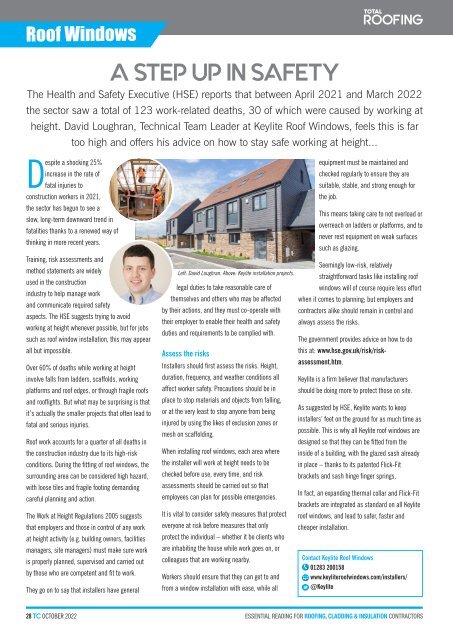October 2022
You also want an ePaper? Increase the reach of your titles
YUMPU automatically turns print PDFs into web optimized ePapers that Google loves.
Roof Windows<br />
A STEP UP IN SAFETY<br />
The Health and Safety Executive (HSE) reports that between April 2021 and March <strong>2022</strong><br />
the sector saw a total of 123 work-related deaths, 30 of which were caused by working at<br />
height. David Loughran, Technical Team Leader at Keylite Roof Windows, feels this is far<br />
too high and offers his advice on how to stay safe working at height...<br />
Despite a shocking 25%<br />
increase in the rate of<br />
fatal injuries to<br />
construction workers in 2021,<br />
the sector has begun to see a<br />
slow, long-term downward trend in<br />
fatalities thanks to a renewed way of<br />
thinking in more recent years.<br />
Training, risk assessments and<br />
method statements are widely<br />
used in the construction<br />
industry to help manage work<br />
and communicate required safety<br />
aspects. The HSE suggests trying to avoid<br />
working at height whenever possible, but for jobs<br />
such as roof window installation, this may appear<br />
all but impossible.<br />
Over 60% of deaths while working at height<br />
involve falls from ladders, scaffolds, working<br />
platforms and roof edges, or through fragile roofs<br />
and rooflights. But what may be surprising is that<br />
it’s actually the smaller projects that often lead to<br />
fatal and serious injuries.<br />
Roof work accounts for a quarter of all deaths in<br />
the construction industry due to its high-risk<br />
conditions. During the fitting of roof windows, the<br />
surrounding area can be considered high hazard,<br />
with loose tiles and fragile footing demanding<br />
careful planning and action.<br />
The Work at Height Regulations 2005 suggests<br />
that employers and those in control of any work<br />
at height activity (e.g. building owners, facilities<br />
managers, site managers) must make sure work<br />
is properly planned, supervised and carried out<br />
by those who are competent and fit to work.<br />
They go on to say that installers have general<br />
Left: David Loughran. Above: Keylite installation projects.<br />
legal duties to take reasonable care of<br />
themselves and others who may be affected<br />
by their actions, and they must co-operate with<br />
their employer to enable their health and safety<br />
duties and requirements to be complied with.<br />
Assess the risks<br />
Installers should first assess the risks. Height,<br />
duration, frequency, and weather conditions all<br />
affect worker safety. Precautions should be in<br />
place to stop materials and objects from falling,<br />
or at the very least to stop anyone from being<br />
injured by using the likes of exclusion zones or<br />
mesh on scaffolding.<br />
When installing roof windows, each area where<br />
the installer will work at height needs to be<br />
checked before use, every time, and risk<br />
assessments should be carried out so that<br />
employees can plan for possible emergencies.<br />
It is vital to consider safety measures that protect<br />
everyone at risk before measures that only<br />
protect the individual – whether it be clients who<br />
are inhabiting the house while work goes on, or<br />
colleagues that are working nearby.<br />
Workers should ensure that they can get to and<br />
from a window installation with ease, while all<br />
equipment must be maintained and<br />
checked regularly to ensure they are<br />
suitable, stable, and strong enough for<br />
the job.<br />
This means taking care to not overload or<br />
overreach on ladders or platforms, and to<br />
never rest equipment on weak surfaces<br />
such as glazing.<br />
Seemingly low-risk, relatively<br />
straightforward tasks like installing roof<br />
windows will of course require less effort<br />
when it comes to planning; but employers and<br />
contractors alike should remain in control and<br />
always assess the risks.<br />
The government provides advice on how to do<br />
this at: www.hse.gov.uk/risk/riskassessment.htm.<br />
Keylite is a firm believer that manufacturers<br />
should be doing more to protect those on site.<br />
As suggested by HSE, Keylite wants to keep<br />
installers’ feet on the ground for as much time as<br />
possible. This is why all Keylite roof windows are<br />
designed so that they can be fitted from the<br />
inside of a building, with the glazed sash already<br />
in place – thanks to its patented Flick-Fit<br />
brackets and sash hinge finger springs.<br />
In fact, an expanding thermal collar and Flick-Fit<br />
brackets are integrated as standard on all Keylite<br />
roof windows, and lead to safer, faster and<br />
cheaper installation.<br />
Contact Keylite Roof Windows<br />
01283 200158<br />
www.keyliteroofwindows.com/installers/<br />
@Keylite<br />
28 TC OCTOBER <strong>2022</strong>

















